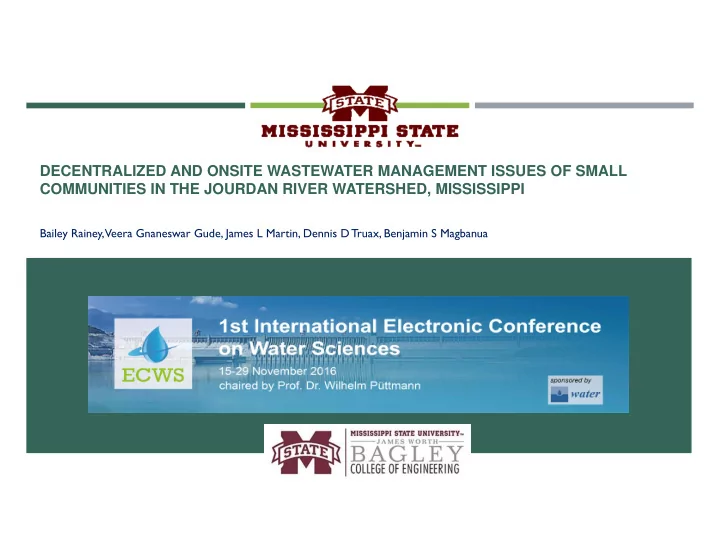

DECENTRALIZED AND ONSITE WASTEWATER MANAGEMENT ISSUES OF SMALL COMMUNITIES IN THE JOURDAN RIVER WATERSHED, MISSISSIPPI Bailey Rainey, Veera Gnaneswar Gude, James L Martin, Dennis D Truax, Benjamin S Magbanua
OVERVIEW Area of Interest – Jourdan River Watershed Nutrient issues in Mississippi’s coastal waters and their implications What is causing these issues? Septic systems – conventional and alternative Identify decentralized communities in the Jourdan River watershed
JOURDAN RIVER WATERSHED Discharges into Bay St. Louis Falls within Hancock County, MS Classified as Recreational Waters Part of the Citronelle Aquifer Bay St. Louis
COASTAL RECREATIONAL WATERS MDEQ State of Mississippi Water Quality Criteria for Intrastate, Interstate, and Coastal Waters EPA Standards TDS = 1500 mg/L (freshwater streams) Iron = 1 mg/L pH = 6.5 – 9.0 Nitrate = 10 mg/L Jourdan River
CITRONELLE AQUIFER MDEQ State of Mississippi Ground Water Quality Assessment: April 2013
NUTRIENT ISSUES IN THE COASTAL WATERS Total Dissolved Solids Standard = 1500 mg/L Range = 12 mg/L to 1690 mg/L Median value = 50 mg/L
NUTRIENT ISSUES IN THE COASTAL WATERS Iron Standard = 1mg/L Range = <0.010 mg/L to 2.5 mg/L Median value = 0.020 mg/L **Determine source**
NUTRIENT ISSUES IN THE COASTAL WATERS pH Standard = 6.5 – 9.0 The pH levels in the Citronelle Aquifer rarely exceed 5.5. Range = 4.1 to 10.3 Median value = 5.4 **Determine source/reprocussions**
NUTRIENT ISSUES IN THE COASTAL WATERS Nitrate Standard = 10 mg/L Range = 0.01 mg/L to 37 mg/L Median value =1.5 mg/L Mostly coming from failing onsite systems Could contribute to hypoxia in the Gulf
ON-SITE TREATMENT UNITS WITHIN THE GULF REGION No. of No. of On ‐ Site Estimated Percentage of Total Estimated Flow from County Housing Units Treatment Units Failing Units Failing Units Failing Units (MGD) George 7649 6597 990 2.67% 0.196 Hancock 22363 12020 7212 19.45% 1.428 Harrison 83631 24019 9608 25.91% 1.902 Jackson 54035 22664 11332 30.56% 2.244 Pearl River 21457 15953 6381 17.21% 1.263 Stone 5445 3899 1560 4.21% 0.309
WHY ARE THEY FAILING? Improper maintenance Unsuitable soil “Approximately two-thirds of all land area in the U.S. is estimated to be unsuitable for the installation of septic systems.”
WHAT DOES THIS MEAN? Untreated, or improperly treated, sewage is being discharged into groundwater and streams. Water quality issues Health issues
ON-SITE TREATMENT SYSTEMS Conventional Septic System Gravity System Pressure Distribution System Alternative Septic Systems Aerobic Treatment Systems Intermittent Sand Filter Systems Recirculating Sand Filter Systems
CONVENTIONAL SEPTIC SYSTEM with Absorption Field Typical treatment levels BOD5 = 10 mg/L TSS = 10 mg/L Fecal coliforms = usually less than 200 per 100mL Doesn’t allow for nitrogen removal without additional treatment Cost System and installation: $1,500 - $4,000 Operation and maintenance: $250 - $550 per year
AEROBIC TREATMENT SYSTEMS***** Mirror many of the steps and activities performed by municipal sewage plants Similar to a conventional septic treatment system, but aerobic systems inject oxygen into the tank Oxygen increases bacterial growth and consumption of waste Most systems include a pretreatment tank and a final treatment tank where chlorine is used instead of sending the effluent to a drainfield for the soil to filter. After the final treatment tank, the effluent can acceptably be directly discharged via sprinklers over the drainfield. Good option for landowners who don’t want to clear trees Good alternative for homeowners on lots close to a body of water that might be polluted through the use of a conventional septic system with a drainfield
SAND FILTER SYSTEMS Intermittent Sand Filters Recirculating Sand Filters Typical treatment levels Typical treatment levels BOD 5 = 95% removal BOD 5 = 95% removal TSS = 85% removal TSS = 95% removal Nitrification of 80%+ of the applied ammonia Almost complete nitrification is achieved Denitrification has also been shown to occur “Depending on modifications in design and operation, 50% or more of the applied nitrogen can be removed.”
SAND FILTER SYSTEMS Intermittent Sand Filters Recirculating Sand Filters After initial costs, After initial costs, yearly cost yearly cost = $150 + Power = $300 + Power
CONTINUING THE STUDY What is causing the failures of these on-site systems? We are looking more into this. Find specific small communities with failing systems contributing to the issues in the Jourdan River Watershed Help them come up with unique solutions Find data specific to the Jourdan River Watershed Can you help us?
Recommend
More recommend